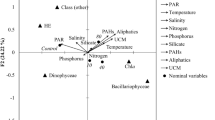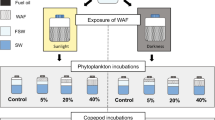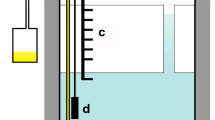Abstract
We conducted controlled laboratory exposure experiments to assess the toxic effects of water-accommodated fractions (WAFs) of South Louisiana sweet crude oil on five phytoplankton species isolated from the Gulf of Mexico. Experiments were conducted with individual and combinations of the five phytoplankton species to determine growth inhibitions to eight total petroleum hydrocarbon (TPH) equivalent concentrations ranging from 461 to 7,205 ppb. The composition and concentration of crude oil were altered by physical and chemical processes and used to help evaluate crude oil toxicity. The impact of crude oil exposure on phytoplankton growth varied with the concentration of crude oil, species of microalgae, and their community composition. At a concentration of TPH < 1,200 ppb, dinoflagellate species showed significantly better tolerance, while diatom species showed a higher tolerance to crude oil at higher concentrations of TPH. For both groups, the larger species were more tolerant to crude oil than smaller ones. The toxicity potential of crude oil seems to be strongly influenced by the concentration of polycyclic aromatic hydrocarbons (PAHs). The addition of the dispersant, Corexit® EC9500A, increased the amount of crude oil up to 50-fold in the water column, while the physical enhancement (vigorous mixing of water column) did not significantly increase the amount of TPH concentration in the water column. The species response to crude oil was also examined in the five-species community. Each phytoplankton species showed considerably less tolerance to crude oil in the five-species community compared to their individual responses. This study provides baseline information about individual phytoplankton responses to crude oil and dispersed crude oil for subsequent research efforts seeking to understand the impacts of oil on the phytoplankton in the bigger picture.









Similar content being viewed by others
References
Adekunle, I., Ajijo, M., Adcofun, C., & Omoniyi, I. (2010). Response of four phytoplankton species found in some sectors of nigerian coastal waters to crude oil in controlled ecosystem. International Journal of Environmental Research, 4(1), 65–74.
Anderson, J. W., Neff, J. M., Cox, B. A., Tatem, H. E., & Hightower, G. M. (1974). Characteristics of dispersions and water-soluble extracts of crude and refined oils and their toxicity to estuarine crustaceans and fish. Marine Biology, 27(1), 75–88.
Bhattacharyya, S., Klerks, P., & Nyman, J. (2003). Toxicity to freshwater organisms from oils and oil spill chemical treatments in laboratory microcosms. Environmental Pollution, 122(2), 205–215.
Brain, P., & Cousens, R. (2006). An equation to describe dose responses where there is stimulation of growth at low doses. Weed Research, 29(2), 93–96.
Couillard, C. M., Lee, K., Légaré, B., & King, T. L. (2009). Effect of dispersant on the composition of the water—accommodated fraction of crude oil and its toxicity to larval marine fish. Environmental Toxicology and Chemistry, 24(6), 1496–1504.
Council, N. R. (2003). Oil in the Sea III: inputs, fates, and effects. Washington: National Academy Press.
CROSERF (2005). Cooperative aquatic toxicity testing of dispersed oil and the “Chemical Response to Oil Spills: Ecological Effects Research Forum (CROSERF). In D. Aurand, & G. Coelho (Eds.), (Vol. Technical Report 07-03, pp. 105). Lusby, MD.: Ecosystem Management & Associates, Inc.
Dunstan, W. M., Atkinson, L. P., & Natoli, J. (1975). Stimulation and inhibition of phytoplankton growth by low molecular weight hydrocarbons. Marine Biology, 31(4), 305–310. doi:10.1007/bf00392087.
Fucik, K. W., Carr, K. A., & Balcom, B. J. (1995). Toxicity of oil and dispersed oil to the eggs and larvae of seven marine fish and inverterbrates from the Gulf of Mexico. ASTM Special Technical Publication(1252), 135–171.
Gilde, K., & Pinckney, J. L. (2012). Sublethal effects of crude oil on the community structure of estuarine phytoplankton. Estuaries and Coasts. 1–9.
Gonzalez, J., Figueiras, F. G., Aranguren-Gassis, M., Crespo, B. G., Fernandez, E., Moran, X. A. G., et al. (2009). Effect of a simulated oil spill on natural assemblages of marine phytoplankton enclosed in microcosms. Estuarine, Coastal and Shelf Science, 83(3), 265–276. doi:10.1016/j.ecss.2009.04.001.
Graham, L. E., Graham, J. M., & Wilcox, L. W. (2009). Algae (2nd ed.). San Francisco: Pearson.
Hook, S. E., & Osborn, H. L. (2012). Comparison of toxicity and transcriptomic profiles in a diatom exposed to oil, dispersants, dispersed oil. Aquatic Toxicology, 124‚125(0), 139–151. doi:10.1016/j.aquatox.2012.08.005.
Howarth, R. W. (1991). Assessing the ecological effects of oil pollution from outer continental shelf oil development. Paper presented at the Fisheries and oil development on the continental shelf, Bethesda, MD.
Hsiao, I. C. S. (1978). Effects of crude oils on the growth of arctic marine phytoplankton. Environmental Pollution, 17(2), 93–107. doi:10.1016/0013-9327(78)90043-5.
Koelmans, A., Van der Heijde, A., Knijff, L., & Aalderink, R. (2001). Integrated modelling of eutrophication and organic contaminant fate & effects in aquatic ecosystems. A review. Water Research, 35(15), 3517–3536.
Lehr, B., Bristol, S., & Possolo, A. (2010). Oil Budget calculator, deepwater horizon, technical documentation, USA. A report by: The Federal Interagency Solutions Group, Oil Budget Calculator Science and Engineering Team.
Litchman, E., & Klausmeier, C. A. (2008). Trait-based community ecology of phytoplankton. Annual Review of Ecology, Evolution, and Systematics, 39, 615–639.
Litchman, E., Klausmeier, C., Miller, J., Schofield, O., & Falkowski, P. (2006). Multi-nutrient, multi-group model of present and future oceanic phytoplankton communities. Biogeosciences Discussions, 3(3), 607–663.
Liu, N., Xiong, D. Q., & Gao, H. (2006). Study on acute toxicity of three fuel oil to marine Chlorella. Marine Environmental Science, 25(1), 29–32.
Mackay, D., & Wolkoff, A. W. (1973). Rate of evaporation of low-solubility contaminants from water bodies to atmosphere. Environmental Science and Technology, 7(7), 611–614.
Miller, M. C., Alexander, V. R., & Barsadate, J. (1978). The effects of oil spill on phytoplankton in Arctic lake and ponds. Artic, 31(3), 192–218.
NALCO (2012). Seven facts about COREXIT 9500 oil dispersant.
Neff, J. M. (1979). Polycyclic Aromatic hydrocarbons in the aquatic environment. London: Applied Science.
NOAA. (2010). Subsurface Oil Monitoring & Ocean Current Data http://www.noaa.gov/deepwaterhorizon/data/subsurface_ocean.html. Accessed 2012.
NRC-National Research Council-Committee on understanding oil spill dispersants: efficacy and effects (2005). Oil Spill Dispersants: Efficacy and Effects: The National Academies Press.
Olenina, I., Hajdu, S., Edler, L., Andersson, A., Wasmund, N., Busch, S., et al. (2006). Biovolumes and size-classes of phytoplankton in the Baltic Sea. Helsinki: Baltic Marine Environment Protection Commission - HELCOM.
OSAT-Operational Science Advisory Team (2010). Summary report for sub-sea and sub-surface oil and dispersant detection: sampling and monitoring (pp. 35). http://www.dep.state.fl.us/deepwaterhorizon/files2/osat_report_17dec.pdf.
Parsons, T. R., Maita, Y., & Lalli, C. M. (1984). A manual of chemical and biological methods for seawater analysis. Oxford: Pergamon Press.
Raven, J. A. (1987). The role of vacuoles. New Phytologist, 106(3), 357–422.
Ritz, C., & Streibig, J. C. (2005). Bioassay analysis using R. Journal of Statistical Software, 12(5), 1–22.
Sicko-Goad, L. M., Schelske, C. L., & Stoermer, E. F. (1984). Estimation of intracellular carbon and silica content of diatoms from natural assemblages using morphometric techniques. Limnology and Oceanography, 29(6), 1170–1178.
Smetacek, V. (1999). Diatoms and the ocean carbon cycle. Protist, 150, 25–32.
Stebbing, A. R. D. (1982). Hormesis—the stimulation of growth by low levels of inhibitors. Science of the Total Environment, 22(3), 213–234.
Stolte, W., & Riegman, R. (1996). A model approach for size-selective competition of marine phytoplankton for fluctuating nitrate and ammonium. Journal of Phycology, 32(5), 732–740.
Sun, J., & Liu, D. (2003). Geometric models for calculating cell biovolume and surface area for phytoplankton. Journal of Plankton Research, 25(11), 1331–1346.
Teal, J. M., & Howarth, R. W. (1984). Oil spill studies: a review of ecological effects. Environmental Management, 8(1), 27–43. doi:10.1007/bf01867871.
Thomas, W. H., Rossi, S. S., & Seibert, D. L. R. (1981). Effects of some representative petroleum refinery effluent compounds on photosynthesis and growth of natural marine phytoplankton assemblages: Part 1—cresols. Marine Environmental Research, 4(3), 203–215.
USEPA (1996). SW-846, Method 8000B. Determinative chromatographic separations: US Environmental Protection Agency.
USEPA (2007). SW-846, Method 8270D. Semivolatile Organic compounds by gas chromatography/mass spectrometry (GC/MS). US Environmental Protection Agency.
Wade, T. L., Sweet, S. T., Sericano, J. L., Guinasso, N. L., Jr., Diercks, A. R., Highsmith, R. C., et al. (2011). Analyses of water samples from the deepwater horizon oil spill: documentation of the subsurface plume. In Monitoring and Modeling the deepwater horizon oil spill: a record-breaking enterprise (Vol. 195, pp. 77-82, Geophys. Monogr. Ser.). Washington, DC: AGU.
Acknowledgments
This research was made possible in part by BP/The Gulf of Mexico Research Initiative, grant number 191001-306811-08/task 5 to Sibel Bargu. We thank to Dr. Eugene Turner for his detailed review and comments for the manuscript. We also thank to Dr. Ronald DeLaune and Dr. Ralph Portier for the dispersant and the crude oil supplies and comments on the manuscript.
Author information
Authors and Affiliations
Corresponding author
Rights and permissions
About this article
Cite this article
Özhan, K., Miles, S.M., Gao, H. et al. Relative Phytoplankton growth responses to physically and chemically dispersed South Louisiana sweet crude oil. Environ Monit Assess 186, 3941–3956 (2014). https://doi.org/10.1007/s10661-014-3670-4
Received:
Accepted:
Published:
Issue Date:
DOI: https://doi.org/10.1007/s10661-014-3670-4




